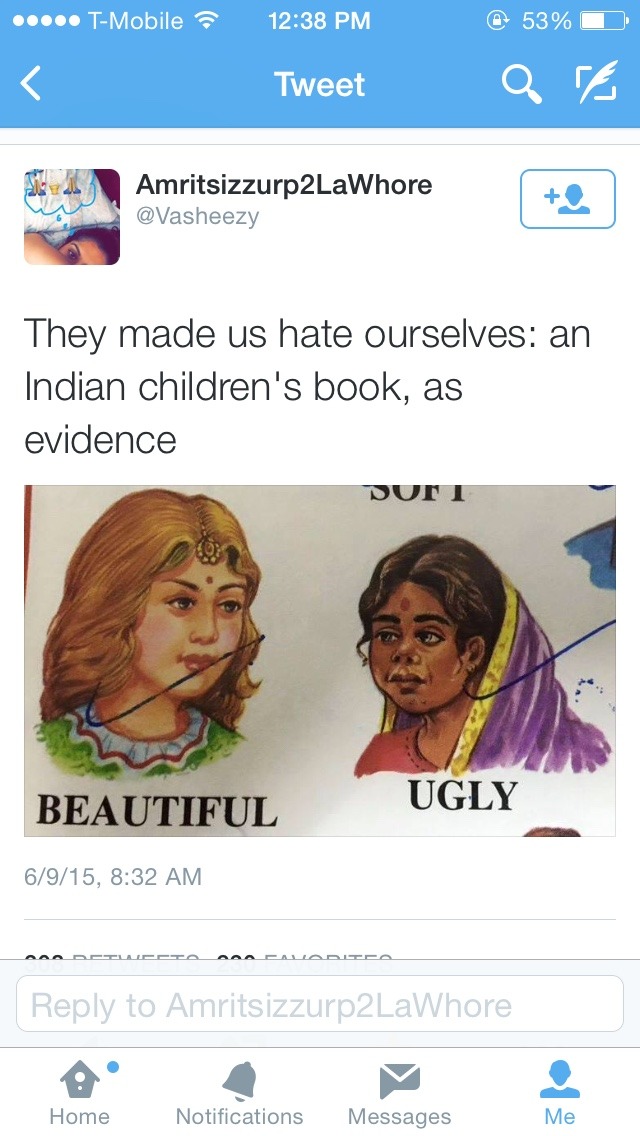saintkathryn:belligerentbagel:pilambdaod:xekstrin:pilambdaod:bengali-babe:“Colorism isn’t real.”Colo
saintkathryn:belligerentbagel:pilambdaod:xekstrin:pilambdaod:bengali-babe:“Colorism isn’t real.”Colorism? Wow because the term “racism” is so blase.pilambdaod Colorism specifically refers to people of their own race valuing lighter skin over darker skin. For example in latina culture, valuing “good” straight hair over “pelo malo” or bad, curly hair.Racism would imply we’re talking about at least two different races here; colorism specifically is about racist ideals within one race, people of one race policing others appearance within their own race. (since this is an indian book, presumably made by indian people for indian children to read, depicting a light skinned indian woman as more beautiful than a dark skinned one, it’s colorism.)One of those is clearly Caucasian the other Indian. Creating random new “isms” only makes legitimate grievances seem petty and stupid.“One of those is clearly Caucasian”Aishwarya Rai, Kareena Kapoor, Kangana Ranaut Karisma Kapoor, Shruti Haasan, Zarine KhanAll actresses/models born in India to parents who were also born in India (or Pakistan), in a narrow view of “race.” If a Papua New Guinean hooks up with a Swedish person all you get is a human. There’s no new thing you’re going to get. You just get a human. - Bill Nye: Race is a Human Construct (and don’t look at the comments; it’s the usual cesspool of bigots) Ideas on “race” have been in slow development over the years, but colourism is a real thing (often with roots in imperialism, especially as Western ideas of beauty began to intrude upon countries). The 100 Years of Beauty: Philippines has a jarring jump where April Villanueva (who has light/medium-toned skin) gets her skin darkened for the 1910s-20s aesthetic, then becomes powder-white when US/European colonial interests make a stronger influence on Philippine society in the 1930s (more in the research video). Two more examples of skin tone variation between famous women in countries where colourism has become prevalent in celebrity culture (ie, it was a lot harder finding photos of a dark-skinned Korean actress than a light-skinned one): Koreans: Song Hye-kyo and Lee Hyori Filipinos: Valerie Garica and Nicole Scherzinger (active in the US; Filipino father, Hawaiian/Samoan-Russian mother) Variation in skin colour across a “race” is as real as variation in eye colour (”oh, you have brown eyes? I guess you’re not a real Caucasian”). Colourism also pervades a lot of modern beauty marketing. What’s underneath your dark skin? A prettier, lighter version of yourself! Everyone should strive to be more fair and lovely because only then you’ll be happy with your flesh prison!! tl;dr colourism exists and isn’t some bogeyman made up by “”es jay double-ews,”” and if you’re the person bemoaning how it “delegitimizes racism” then it’s likely you actually don’t care about racism at all and are just trying to devalue the arguments with the classic “but so-and-so people have it worse! how could you be so self-centered and selfish??” Also “colorism” was coined by Alice Walker in 1982. This is not some new internet fad. -- source link
